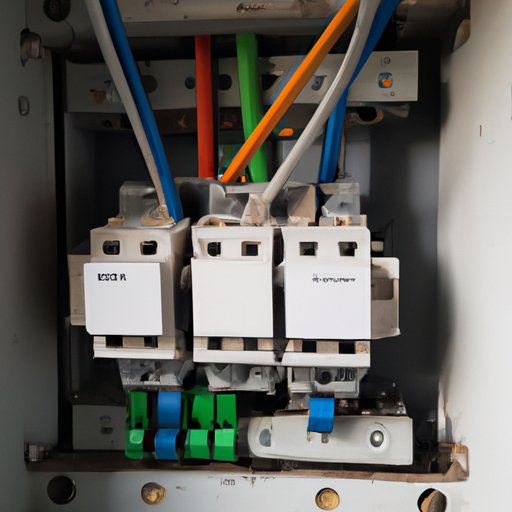Introduction
Circuit breakers are essential components of any home’s electrical system. When too much electricity flows through a circuit, the breaker trips, cutting off the power supply and protecting the circuit from overheating and potential fire hazards. But when a circuit breaker trips too often, it can be frustrating and difficult to figure out why.
What is a Circuit Breaker and Why Does it Trip?
A circuit breaker is an electronic device that protects an electrical circuit from damage caused by excessive current or overload. The breaker trips when too much current passes through it, interrupting the flow of electricity and preventing the circuit from becoming overloaded. This is a safety feature designed to protect both your home and its occupants from electrical hazards.
Overview of the Problem
When a circuit breaker trips, it can be difficult to determine the cause. It could be due to an overloaded circuit, faulty wiring, or a ground fault. To properly diagnose and fix the problem, you must first identify the source of the issue. Once you know the cause, you can take the necessary steps to repair the circuit breaker and restore power to the affected area.

Identify the Cause of the Breaker Tripping
The first step in fixing a tripping circuit breaker is to identify the cause of the problem. There are several possible causes, including overloaded circuits, faulty wiring, and ground faults.
Check for Overloaded Circuits
An overloaded circuit occurs when too many appliances or devices are plugged into the same circuit. This can cause the circuit breaker to trip, as it cannot handle the high amount of current flowing through the circuit. To prevent this from happening, make sure that each circuit is not overloaded with too many devices.
Check for Faulty Wiring
Faulty wiring can also cause a circuit breaker to trip. If the wiring is old or damaged, it may be unable to handle the current and cause the breaker to trip. Make sure all wiring is up to code and in good condition to avoid this issue.
Check for Ground Faults
Ground faults occur when electricity escapes from its intended path and travels through the ground. This can cause the circuit breaker to trip, as it is designed to protect against this type of fault. To prevent ground faults, make sure all wiring is properly connected and grounded.
Replace the Circuit Breaker
If the cause of the tripping circuit breaker is unknown, or if the breaker itself is faulty, you may need to replace it. Replacing a circuit breaker is relatively easy, but you should always exercise caution when working with electricity. Here are the steps for replacing a circuit breaker:
Shut Off Power to the Circuit
Before you begin, make sure the power to the circuit is shut off. You can do this by switching off the main power switch in your home’s electrical panel. This will ensure that no electricity is flowing through the circuit while you are working on it.
Remove the Old Breaker
Once the power is off, you can remove the old breaker. Carefully unscrew the screws holding the breaker in place and gently pull it out of the panel. Be careful not to touch any live wires while doing this.
Install the New Breaker
Now you can install the new breaker. Insert the new breaker into the panel and secure it with the screws. Connect the wires to the terminals and make sure all connections are tight. Finally, turn the main power switch back on to restore power to the circuit.
Check for Loose Wires
Sometimes the cause of a tripping circuit breaker is not the breaker itself, but rather loose connections in the electrical panel. To check for loose wires, inspect the panel and look for any frayed or exposed wires. If you find any, tighten the connections to ensure that they are secure.
Upgrade the Electrical Panel
If your home’s electrical panel is outdated or inadequate, it may be causing the circuit breaker to trip. To upgrade the panel, you can add additional circuits or replace old breakers with new ones. This will ensure that the panel can handle the current load and prevent the breaker from tripping.
Install a Ground Fault Circuit Interrupter (GFCI)
A ground fault circuit interrupter, or GFCI, is a device that detects ground faults and trips the circuit breaker before it becomes dangerous. To install a GFCI, you must first determine if one is required. If so, install a GFCI outlet in the affected area to provide additional protection.
Increase the Number of Circuits in the Panel
If your home’s electrical panel does not have enough circuits to meet your needs, you may need to increase the number of circuits in the panel. To do this, you must first determine the necessary number of circuits. Then, install the necessary number of circuits in the panel to ensure that there is enough capacity for all of your electrical devices.
Conclusion
If your circuit breaker keeps tripping, it can be difficult to determine the cause. However, by following the steps outlined above, you can identify the source of the problem and take the necessary steps to repair the circuit breaker and restore power to the affected area. With a little bit of patience and the right knowledge, you can get your circuit breaker up and running again in no time.
(Note: Is this article not meeting your expectations? Do you have knowledge or insights to share? Unlock new opportunities and expand your reach by joining our authors team. Click Registration to join us and share your expertise with our readers.)
